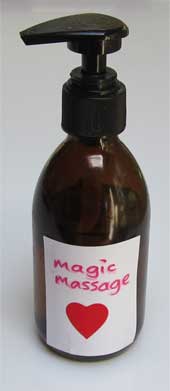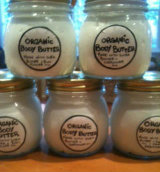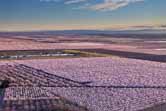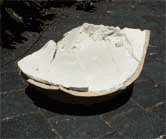Home / Past Newsletters / February 2014
February 2014
New Year greetings from all of us - hope you have been enjoying some relaxing summer days, and are now feeling full of optimism for the year ahead.
In this issue:
Valentine's Day - 14 February
Beautiful handmade gifts are fun to make, and creating a unique gift for someone special is always satisfying. At Go Native, we believe that a little thought and creativity goes a lot further than spending hundreds of dollars.
We've included just a few ideas here, but the possibilities are endless. So have a look here, and maybe on our website (Recipes) and you will come up with something unique. Have fun, and surprise your beloved with something made with your own loving hands!
Make your own massage oil

Massage oil is a gift that keeps on giving – and once you’ve done some massaging, you might just receive one as well!
It can be as simple or as sophisticated as you like.
Many massage therapists use almond oil alone, as it’s not only nice to use, but it’s great value. We have two high-quality almond oils:
- cold-pressed virgin certified organic sweet almond oil
- cold-pressed refined sweet almond oil
There is also our almond massage blend, with Polysorbate 80 so the oil washes out of towels and sheets (but the smallest quantity is one litre).
What you need:
- almond oil (and maybe other oils)
- container (a recycled bottle?) and dispenser
- fragrance
- measuring cup or bowl for mixing
- label
Choose a bottle that gives protection from light – maybe the brown glass bottle that the oil came in. A lotion pump is a great dispenser, and looks cute cut down to fit even a 100ml bottle. Once you have a bottle, you know how much oil to blend.
Selecting oils
You may want to use 100% almond oil.
Or you can make a special blend with say 60% almond, and up to 30% of one or more other oils.
Fragrance
Fragrance will make your gift memorable. And if you are the one doing the massaging, you get to enjoy it too.
Maybe you delight in blending perfumes, or maybe you’d like to keep it simple, with just a few drops of something that smells wonderful.
Therapeutic grade essential oils: These bring healing qualities as well as fragrance. Here are some that most men (and many women) enjoy:
Cosmetic grade essential oils: These provide high-quality fragrance, but without the healing properties of the therapeutic grade oils.
Rosewood and Yuzu are likely to appeal to men, and a touch of Vanilla can be great in fragrance blends.
Fragrance oils: Coffee, chocolate… a bit wacky in a massage oil??
There are also a host of fruity fragrances, all with subtlety and depth.
Make a label
– as simple or ornate as you like. (If you have a tacky side, like me, most $2 shops have a huge range of stickers!!) Chelsea made the body butter and labels in the photo for her friends...
Writing the date on the label is a good idea. Or put the Best Before date from your oldest ingredient.
If you need a label or two, just let us know when you order.
 Melt and pour soap
Melt and pour soap
Melt and pour soap is so much fun, and virtually foolproof - though it needs a bit of care when you are using two colours, as in this LOVE mould.
We have put together a new LOVE mini kit for Valentine's Day, containing everything you need: Mould, melt and pour soap, green mica, coconut and lime fragrance oil, and instructions.
(You'll find it as an extra option for the red LOVE kit.)
Designed to appeal to the man in your life!
In this issue:
- Valentine's Day gifts to make: massage oil, LOVE soap
- New recipes: Go Native manuka body butter, Kawakawa and shea lemon hand cream
- What does it mean? Wildcrafted, certified organic, spray free
- Some oil containers change with the seasons
Valentine's Day - 14 February
Beautiful handmade gifts are fun to make, and creating a unique gift for someone special is always satisfying. At Go Native, we believe that a little thought and creativity goes a lot further than spending hundreds of dollars.
We've included just a few ideas here, but the possibilities are endless. So have a look here, and maybe on our website (Recipes) and you will come up with something unique. Have fun, and surprise your beloved with something made with your own loving hands!
Make your own massage oil

Massage oil is a gift that keeps on giving – and once you’ve done some massaging, you might just receive one as well!
It can be as simple or as sophisticated as you like.
Many massage therapists use almond oil alone, as it’s not only nice to use, but it’s great value. We have two high-quality almond oils:
- cold-pressed virgin certified organic sweet almond oil
- cold-pressed refined sweet almond oil
There is also our almond massage blend, with Polysorbate 80 so the oil washes out of towels and sheets (but the smallest quantity is one litre).
What you need:
- almond oil (and maybe other oils)
- container (a recycled bottle?) and dispenser
- fragrance
- measuring cup or bowl for mixing
- label
Choose a bottle that gives protection from light – maybe the brown glass bottle that the oil came in. A lotion pump is a great dispenser, and looks cute cut down to fit even a 100ml bottle. Once you have a bottle, you know how much oil to blend.
Selecting oils
You may want to use 100% almond oil.
Or you can make a special blend with say 60% almond, and up to 30% of one or more other oils.
- Organic sunflower oil is great for summer skin.

- New Zealand nut oils add nutrients – hazelnut and/or walnut are great.
- Jojoba has a silky feel, giving great glide.
- Grape seed oil is light on the skin, leaving no greasy feeling.
- Consider including an infused oil - eg, arnica for a serious sportsman.
Fragrance
Fragrance will make your gift memorable. And if you are the one doing the massaging, you get to enjoy it too.
Maybe you delight in blending perfumes, or maybe you’d like to keep it simple, with just a few drops of something that smells wonderful.
Therapeutic grade essential oils: These bring healing qualities as well as fragrance. Here are some that most men (and many women) enjoy:
- Bergamot is extracted from a member of the citrus family, but with a relaxing warm richness. Avoid just before sun exposure.
- Frankincense has a clean, spicy aroma and a wide range of healing properties.
- Ylang ylang has an exotic perfume and soothes away stress.
- Palmarosa comes from a plant related to lemongrass, and also has stress-relieving properties.
- West Indian Sandalwood is relaxing and calming.
- Australian Sandalwood is refreshing yet sensuous – and brings its sensual qualities into any blend.
- Patchouli's fragrance is a bit exotic. It brings stress levels back to normal and encourages relaxing sleep.
- Vetiver is earthy and warm, relaxing and comforting.
Cosmetic grade essential oils: These provide high-quality fragrance, but without the healing properties of the therapeutic grade oils.
Rosewood and Yuzu are likely to appeal to men, and a touch of Vanilla can be great in fragrance blends.
Fragrance oils: Coffee, chocolate… a bit wacky in a massage oil??
There are also a host of fruity fragrances, all with subtlety and depth.
Make a label

– as simple or ornate as you like. (If you have a tacky side, like me, most $2 shops have a huge range of stickers!!) Chelsea made the body butter and labels in the photo for her friends...
Writing the date on the label is a good idea. Or put the Best Before date from your oldest ingredient.
If you need a label or two, just let us know when you order.
 Melt and pour soap
Melt and pour soapMelt and pour soap is so much fun, and virtually foolproof - though it needs a bit of care when you are using two colours, as in this LOVE mould.
We have put together a new LOVE mini kit for Valentine's Day, containing everything you need: Mould, melt and pour soap, green mica, coconut and lime fragrance oil, and instructions.
(You'll find it as an extra option for the red LOVE kit.)
Designed to appeal to the man in your life!
Two new recipes:
Go Native NZ manuka body butter
Makes 200g
Oil Phase (OP) :
50g NZ organic beeswax
50g emulsifier O
10g NZ kawakawa infused oil
10g NZ blackcurrant seed oil
10g NZ hazelnut oil
10g NZ walnut oil
Water Phase (WP):
150g water
50g manuka extract
Last Phase (LP):
2g Geogard 221
2g manuka essential oil
1. In two small pots, heat the OP ingredients until melted. Heat the WP ingredients to 65°C.
2. When both phases are 65°C combine the two into one pot and blend with a stick blender until it begins to thicken.
3. Add the LP ingredients and blend.
4. Spoon into jars.
Check out our 200ml glass jars - they are quite solid, ideal for body butter.
Kawakawa and shea lemon hand cream
Makes 150g
Water Phase (WP):
100g water
1g aloe powder
4g glycerin
Oil Phase (OP):
20g kawakawa infused oil
10g shea butter
10g conditioner pellets
Last Phase (LP):
1g Geogard 221
1g lemon essential oil
Method:
What does it mean?
Wildcrafted - Certified Organic - Spray free
How do you compare wildcrafted with certified organic or spray free? Many of you have been asking about these kinds of words, so it seems a good time to re-do a series on the terms you'll find on our website.
When you look at the ingredients available on our website, there are all these words that you usually take for granted: cold pressed, organic, unrefined, refined, spray free, …
And they come in clumps: organic cold pressed unrefined, or even (spot the difference) organic cold pressed refined. How does this compare with spray free expeller-pressed? How about deodorised? distilled? ultra refined? extra virgin?
In each newsletter I (that's me, Jacqui) will look at a few of these.
This time: wildcrafted, certified organic, spray free.
Wildcrafted is something collected in a traditional way by its traditional collectors, in quantities that are sustainable. In the tropical regions of the world there are still people living close to the land with skills and knowledge that has been handed down for generations.
While much so-called development has destroyed the lives of ordinary people, there are some Western aid agencies that have made it possible for women in particular to make a living from traditional activities.
Their products are different from the mass-produced versions. For example, along with many of you, we absolutely adore our wildcrafted shea butter. But some people find the aroma just too raw and overpowering.
Wildcrafted products will not always be the same. We have become so accustomed to factory-style farming that we don’t know what to think when the new batch is a different colour from the old, or has a different smell – reflecting local conditions at the time it was growing, and the way it was handled after harvest.
Organic is the way things were grown for thousands of years, until about a hundred years ago the new science of chemistry started coming up with apparently instant fixes for the age-old problems of the gardener and farmer. But now we realise that there are always side effects.
For example, DDT was good at killing insects (and by reducing the mosquito population, made a big dent in the number of South Pacific malaria cases) – but it also had unexpected effects such as thinning the eggshells of wild birds such as eagles, so their numbers plummeted in the 1950’s, when DDT was used everywhere.
Soil fertility has always been an issue. At a working farm museum in Switzerland, I saw the huge effort that used to go into burning bones and crushing them for their precious phosphorus. Now we mine phosphate deposits and make them into quick-fix superphosphate, which functions a bit like an energy drink for grass. Organic farmers can only use the untreated phosphate rock, which feeds plants more slowly.
One of the underlying ideas of traditional farming was variety. Have you ever been to a farm that has fruit trees, shelter and fodder trees, a big herb garden, a vegetable garden, chickens, ducks, pigs, cattle, sheep, horses,…?? These magical places still exist, and their diversity is their strength. All those creatures eat different things, and pests have much less chance of taking over. The best examples that I know of are farmed according to the ideas of Dr Rudolf Steiner, a version of organics called Biodynamic farming. (Go Native has some beautiful New Zealand olive oil that is grown biodynamically and Demeter certified.)
their strength. All those creatures eat different things, and pests have much less chance of taking over. The best examples that I know of are farmed according to the ideas of Dr Rudolf Steiner, a version of organics called Biodynamic farming. (Go Native has some beautiful New Zealand olive oil that is grown biodynamically and Demeter certified.)
I recently read an article comparing a healthy organic farm to a coral reef. The reef is an incredibly complex system with creatures of all kinds, from microscopic bacteria and viruses to algae to sharks, all living in a stable state. The idea of pouring truckloads of a fertiliser on a coral reef, to encourage one marketable thing to grow, seems bizarre. Ideally, organic farms have the same kind of resilience as the untouched coral reef - but have to be farmed with sensitivity to the real needs of the land and animals.

The most popular certification system in New Zealand is Biogro. We have three wonderfully potent Biogro essential oils: Organic teatree, organic manuka and organic kanuka.

In other countries, ‘certified organic’ seems to be turning into another kind of mass production. There are huge farms in California that grow only one plant – almond trees, for example – and get by because they are expert at juggling and pushing and redefining what goes into the farm. But they have their problems. For example, the bees that are shunted around the USA to do mass pollination are dying in worrying numbers.
We have two versions of many of our oils: one from conventionally grown plants, and also certified organic oil, processed using organic practices from organically grown plants.
Spray free usually indicates a producer who farms according to organic principles (otherwise they’d need to spray!) but doesn’t wish to go through the rigmarole of certification, which takes time – lots of forms to fill in and records to keep – and money. Sometimes it can take a lot of money.
The most amazing avocado producer I’ve come across doesn't certify their produce, yet applies the principles of biodynamics and other stringent organic systems along with some pretty funky ideas based on their observations of avocado trees in the wild - and the end result is wonderful.
We have wonderful oils from small NZ producers who are not certified organic, but who care for their trees with minimal chemical input. Our hazelnut oil and walnut oil are divine!
Summer oil containers
Oils such as coconut and palm are solid in winter, but at this time of the year in hot weather they are liquid. The pails aren't designed for liquids and they sometimes leak. So, when the weather is hot, we pack these oils in jerrycans, so we don't get complaints of leaks.
We realise that this is a nuisance for those of you who live in cooler climes! All we can suggest is that you save your pails (or other suitable containers) so that when you warm your jerrycan, you can transfer the contents to a pail so you've got easy access.
All the best for 2014 - and have a great time being creative!
Kind regards
Elinor, Chelsea, & Jacqui
Go Native NZ manuka body butter
Makes 200g
Oil Phase (OP) :
50g NZ organic beeswax
50g emulsifier O
10g NZ kawakawa infused oil
10g NZ blackcurrant seed oil
10g NZ hazelnut oil
10g NZ walnut oil
Water Phase (WP):
150g water
50g manuka extract
Last Phase (LP):
2g Geogard 221
2g manuka essential oil
1. In two small pots, heat the OP ingredients until melted. Heat the WP ingredients to 65°C.
2. When both phases are 65°C combine the two into one pot and blend with a stick blender until it begins to thicken.
3. Add the LP ingredients and blend.
4. Spoon into jars.
Check out our 200ml glass jars - they are quite solid, ideal for body butter.
Kawakawa and shea lemon hand cream
Makes 150g
Water Phase (WP):
100g water
1g aloe powder
4g glycerin
Oil Phase (OP):
20g kawakawa infused oil
10g shea butter
10g conditioner pellets
Last Phase (LP):
1g Geogard 221
1g lemon essential oil
Method:
- Heat the OP ingredients until melted. Heat the WP ingredients to 65°C.
- When both phases are 65°C combine the two and beat with a stick blender.
- When it is beginning to thicken, add LP and blend.
- Spoon into a container.
What does it mean?
Wildcrafted - Certified Organic - Spray free
How do you compare wildcrafted with certified organic or spray free? Many of you have been asking about these kinds of words, so it seems a good time to re-do a series on the terms you'll find on our website.
When you look at the ingredients available on our website, there are all these words that you usually take for granted: cold pressed, organic, unrefined, refined, spray free, …
And they come in clumps: organic cold pressed unrefined, or even (spot the difference) organic cold pressed refined. How does this compare with spray free expeller-pressed? How about deodorised? distilled? ultra refined? extra virgin?
In each newsletter I (that's me, Jacqui) will look at a few of these.
This time: wildcrafted, certified organic, spray free.
Wildcrafted is something collected in a traditional way by its traditional collectors, in quantities that are sustainable. In the tropical regions of the world there are still people living close to the land with skills and knowledge that has been handed down for generations.
While much so-called development has destroyed the lives of ordinary people, there are some Western aid agencies that have made it possible for women in particular to make a living from traditional activities.
Their products are different from the mass-produced versions. For example, along with many of you, we absolutely adore our wildcrafted shea butter. But some people find the aroma just too raw and overpowering.
| Our wild shea butter arrives in the most natural of packaging - a huge gourd. We have to crack it open to get at the shea! Here is a piece - it's about 20cm by 30cm. |  |
Organic is the way things were grown for thousands of years, until about a hundred years ago the new science of chemistry started coming up with apparently instant fixes for the age-old problems of the gardener and farmer. But now we realise that there are always side effects.
For example, DDT was good at killing insects (and by reducing the mosquito population, made a big dent in the number of South Pacific malaria cases) – but it also had unexpected effects such as thinning the eggshells of wild birds such as eagles, so their numbers plummeted in the 1950’s, when DDT was used everywhere.
Soil fertility has always been an issue. At a working farm museum in Switzerland, I saw the huge effort that used to go into burning bones and crushing them for their precious phosphorus. Now we mine phosphate deposits and make them into quick-fix superphosphate, which functions a bit like an energy drink for grass. Organic farmers can only use the untreated phosphate rock, which feeds plants more slowly.
One of the underlying ideas of traditional farming was variety. Have you ever been to a farm that has fruit trees, shelter and fodder trees, a big herb garden, a vegetable garden, chickens, ducks, pigs, cattle, sheep, horses,…?? These magical places still exist, and their diversity is
 their strength. All those creatures eat different things, and pests have much less chance of taking over. The best examples that I know of are farmed according to the ideas of Dr Rudolf Steiner, a version of organics called Biodynamic farming. (Go Native has some beautiful New Zealand olive oil that is grown biodynamically and Demeter certified.)
their strength. All those creatures eat different things, and pests have much less chance of taking over. The best examples that I know of are farmed according to the ideas of Dr Rudolf Steiner, a version of organics called Biodynamic farming. (Go Native has some beautiful New Zealand olive oil that is grown biodynamically and Demeter certified.)I recently read an article comparing a healthy organic farm to a coral reef. The reef is an incredibly complex system with creatures of all kinds, from microscopic bacteria and viruses to algae to sharks, all living in a stable state. The idea of pouring truckloads of a fertiliser on a coral reef, to encourage one marketable thing to grow, seems bizarre. Ideally, organic farms have the same kind of resilience as the untouched coral reef - but have to be farmed with sensitivity to the real needs of the land and animals.

The most popular certification system in New Zealand is Biogro. We have three wonderfully potent Biogro essential oils: Organic teatree, organic manuka and organic kanuka.

In other countries, ‘certified organic’ seems to be turning into another kind of mass production. There are huge farms in California that grow only one plant – almond trees, for example – and get by because they are expert at juggling and pushing and redefining what goes into the farm. But they have their problems. For example, the bees that are shunted around the USA to do mass pollination are dying in worrying numbers.
We have two versions of many of our oils: one from conventionally grown plants, and also certified organic oil, processed using organic practices from organically grown plants.
Spray free usually indicates a producer who farms according to organic principles (otherwise they’d need to spray!) but doesn’t wish to go through the rigmarole of certification, which takes time – lots of forms to fill in and records to keep – and money. Sometimes it can take a lot of money.
The most amazing avocado producer I’ve come across doesn't certify their produce, yet applies the principles of biodynamics and other stringent organic systems along with some pretty funky ideas based on their observations of avocado trees in the wild - and the end result is wonderful.
We have wonderful oils from small NZ producers who are not certified organic, but who care for their trees with minimal chemical input. Our hazelnut oil and walnut oil are divine!
Summer oil containers

Oils such as coconut and palm are solid in winter, but at this time of the year in hot weather they are liquid. The pails aren't designed for liquids and they sometimes leak. So, when the weather is hot, we pack these oils in jerrycans, so we don't get complaints of leaks.
We realise that this is a nuisance for those of you who live in cooler climes! All we can suggest is that you save your pails (or other suitable containers) so that when you warm your jerrycan, you can transfer the contents to a pail so you've got easy access.
All the best for 2014 - and have a great time being creative!
Kind regards
Elinor, Chelsea, & Jacqui
